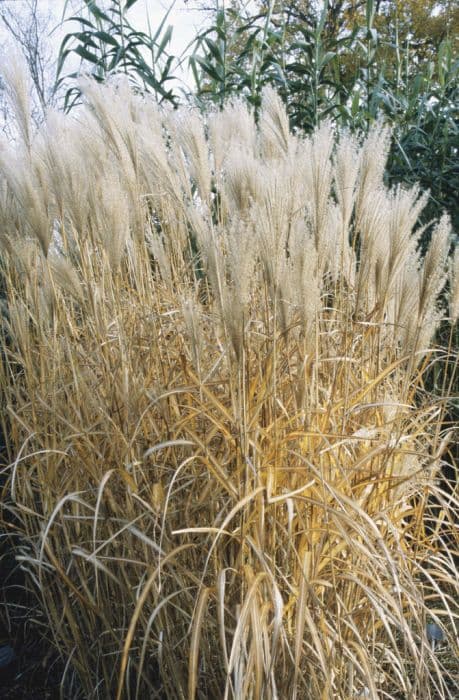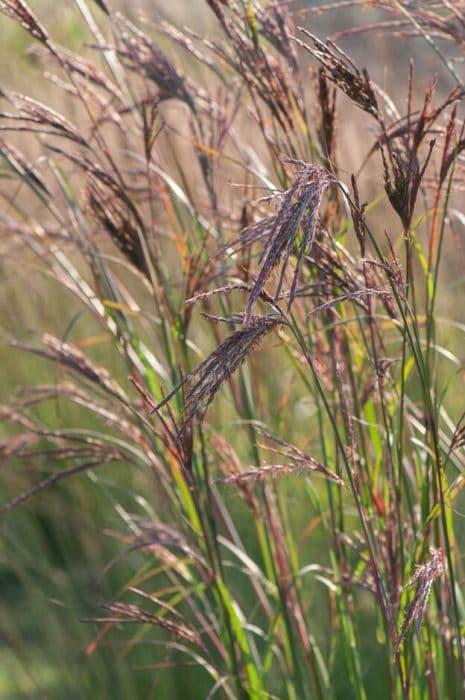Lemongrass Cymbopogon citratus
















ABOUT
Cymbopogon citratus, commonly known as lemongrass, is a tropical plant known for its distinct lemon-like scent and flavor. The plant features slender, long, arching leaves that are pale to bright green in color. These leaves are razor-edged, with a pointed tip and cascade like a fountain from the central stalk. The texture of the leaves is rough and slightly brittle, and they can develop a yellow tinge if they become dry. The base of the lemongrass plant, where the leaves emerge, often displays a bulbous appearance, with layers of leaves wrapping around each other in a dense cluster. Lemongrass produces tall, thin stalks which, when sliced, reveal a whitish interior. The base of the stalk is where the most flavor and fragrance are concentrated, making it highly sought after for use in culinary dishes and teas. Frequently, the plant will release a strong citrusy aroma when the leaves are bruised or crushed. Its appearance in a garden is similar to that of tall grasses, with leaves that move with the wind, creating a visually soothing effect. Lemongrass does not typically bear conspicuous flowers when grown outside its native habitat or without specific cultivation techniques, so it is primarily grown for its foliage and aromatic qualities.
About this plant
 Names
NamesFamily
Poaceae
Synonyms
Lemongrass, Lemon Grass, Barbed Wire Grass, Silky Heads, Cochin Grass, Malabar Grass, Oily Heads, Fever Grass
Common names
Andropogon citratus, Andropogon schoenanthus var. citratus, Cymbopogon ceriferus, Cymbopogon citriodorus, Cymbopogon nardus var. citriodorus.
 Toxicity
ToxicityTo humans
Lemongrass is generally recognized as safe for human consumption when used as a herb or consumed in foods and beverages. However, consuming large amounts can potentially lead to adverse effects, such as allergic reactions or skin irritation in sensitive individuals. There is no significant toxicity associated with lemongrass, and it does not typically cause poisoning when ingested in customary amounts as a flavoring or tea. As with any plant or herb, moderation is key, and it is always advisable to consult a healthcare professional if you have concerns regarding its use.
To pets
Lemongrass is considered non-toxic to pets, including cats and dogs. However, if a pet ingests a large amount of the plant, it may experience gastrointestinal upset, such as vomiting or diarrhea. Because the grass can be fibrous, it might cause mechanical irritation in the stomach or intestines of some pets, potentially leading to discomfort. In pets with particular sensitivities, or if ingested in very large quantities, more severe symptoms could occur. Pet owners should always monitor their animals when introducing new plants into the environment and consult with a veterinarian if there are any signs of adverse reactions after ingestion.
 Characteristics
CharacteristicsLife cycle
Perennials
Foliage type
Evergreen
Color of leaves
Green
Height
3-6 feet (0.91-1.83 meters)
Spread
2-4 feet (0.61-1.22 meters)
Plant type
Herb
Hardiness zones
9
Native area
Asia
Benefits
 General Benefits
General Benefits- Supports Digestion: Cymbopogon citratus, commonly known as lemongrass, is often used in teas and cuisines that can aid in digestion.
- Aromatic: Lemongrass has a strong, pleasant lemony scent that is often used in perfumes, scented oils, and aromatherapy products.
- Culinary Uses: Lemongrass is a popular herb in many Asian cuisines, giving dishes a fresh, lemony flavor.
- Insect Repellent: The natural oils in lemongrass are effective in repelling insects such as mosquitoes.
- Stress Reduction: The soothing aroma of lemongrass can be used in essential oils for a calming effect, reducing stress and anxiety.
- Skin Health: Lemongrass is used in some skincare products for its cleansing and astringent properties.
 Medical Properties
Medical Properties- Analgesic: Cymbopogon citratus has been used to help reduce pain.
- Antipyretic: It is sometimes utilized to help reduce fever.
- Antispasmodic: The plant has properties that may relieve muscle spasms.
- Antibacterial: It possesses compounds that are effective against certain bacteria.
- Antifungal: The plant contains elements that can inhibit fungal growth.
- Antioxidant: Cymbopogon citratus is known for its antioxidant properties, helping to neutralize free radicals in the body.
- Anxiolytic: It is purported to have a calming effect, reducing anxiety.
- Carminative: The plant can help relieve flatulence and digestive issues.
- Hypoglycemic: It may be beneficial in lowering blood sugar levels.
- Anti-inflammatory: Compounds in the plant might reduce inflammation.
- Sedative: It is traditionally used for its sedative properties to promote relaxation and improve sleep quality.
- Digestive aid: Cymbopogon citratus can be used to aid digestion.
- Anticancer: Some research suggests that the plant contains compounds that may have anticancer properties.
 Air-purifying Qualities
Air-purifying QualitiesThis plant is not specifically known for air purifying qualities.
 Other Uses
Other Uses- Cymbopogon citratus, commonly known as lemongrass, can be used as a natural dye. The plant’s leaves contain compounds that can impart a yellow to brown tint on fabrics.
- Lemongrass serves as a natural preservative due to its antibacterial properties and can be used to extend the shelf life of certain perishable foods.
- It's often planted in gardens as a natural pest repellent due to its strong citrus-like aroma which is unappealing to many insects, including mosquitoes.
- In crafting, dried lemongrass can be incorporated into potpourri blends for a refreshing and long-lasting scent.
- Lemongrass stalks are used in some traditional forms of puppet-making to create lightweight and aromatic components.
- The essential oil extracted from lemongrass is used in aromatherapy as a way to help reduce stress and improve mood.
- The plant can be used in the papermaking process, where its fibers are incorporated into the mash to create textured, fragrant paper products.
- Lemongrass is popular in the culinary arts not just as a flavoring but also as an aromatic skewer for grilling meats and vegetables which infuses the food with its scent.
- Used as a natural polish, lemongrass oil can help to maintain wooden furniture and hardwood floors, leaving a natural sheen and light fragrance.
- In textile art, lemongrass leaves can be braided or woven to create eco-friendly and scented accessories like bracelets, hats, or bags.
Interesting Facts
 Feng Shui
Feng ShuiLemongrass is not used in Feng Shui practice.
 Zodiac Sign Compitability
Zodiac Sign CompitabilityLemongrass is not used in astrology practice.
 Plant Symbolism
Plant Symbolism- Cleansing - Cymbopogon citratus, commonly known as Lemongrass, is often associated with cleansing properties both in a literal sense, due to its antiseptic qualities, and in a spiritual sense, as it is believed to purify spaces and remove negative energy.
- Healing - Lemongrass symbolizes healing owing to its numerous health benefits like relieving pain, reducing fever, improving digestion, and boosting oral health.
- Refreshing – The bright, citrus scent of Lemongrass is emblematic of a refreshing and revitalizing sensation, akin to a clean and fresh atmosphere after rain.
- Protection - In some cultures, Lemongrass is believed to offer protection by warding off evil spirits or negative influences when used in rituals or kept within the home.
- Tranquility - The soothing aroma of Lemongrass is thought to promote calmness and tranquility, reducing stress and anxiety, and thus it symbolizes peace of mind.
- Clarity – The strong and uplifting scent of Lemongrass is said to aid in mental clarity and help in focusing, making it a symbol for clear thinking and concentration.
 Water
WaterLemon grass (Cymbopogon citratus) prefers consistent moisture, so water the plant when the top inch of soil feels dry to the touch. Generally, this means watering about once a week, but frequency may need to increase during hot, dry periods. Use approximately 1/4 to 1/2 gallon of water per plant, ensuring an even distribution around the base without flooding the area. During the winter or in cooler climates, reduce watering to prevent root rot, as the plant's water requirements will decrease.
 Light
LightLemon grass thrives in full sun, meaning it needs at least 6 hours of direct sunlight per day to grow healthily. The best spot for lemon grass is an area where it can receive unfiltered sunlight throughout the day. If grown indoors, place it near a south-facing window to ensure it gets enough light.
 Temperature
TemperatureLemon grass prefers warm temperatures, ideally between 64°F and 77°F, and it can survive in temperatures up to 90°F. The minimum temperature lemon grass can tolerate is around 40°F; below that, the plant is at risk of damage. Protect the plant from frost and ensure it is kept warm during the cooler months.
 Pruning
PruningPruning lemon grass helps maintain its health by removing dead or yellow leaves and encourages new growth. Trim back the plant in early spring before new growth begins, cutting about a third of its height. Additionally, prune as needed throughout the year to shape the plant and harvest the stalks for culinary use.
 Cleaning
CleaningAs needed
 Soil
SoilLemongrass prefers a well-draining soil mix with a substantial amount of organic matter such as compost or well-rotted manure. A good mix might be two parts garden soil to one part compost with additional perlite or sand for improved drainage. The ideal soil pH for lemongrass is between 6.0 and 7.0.
 Repotting
RepottingLemongrass should be repotted once it outgrows its pot, which is typically every couple of years. If the roots start to circle the pot or come out of the drainage holes, it's time to repot this fast-growing plant.
 Humidity & Misting
Humidity & MistingLemongrass thrives best in high humidity conditions, similar to its tropical origin environment. Aim for a humidity level above 40%, which should suit the plant well for robust growth.
 Suitable locations
Suitable locationsIndoor
Place lemongrass in bright light and keep soil consistently moist.
Outdoor
Lemongrass needs full sun, well-draining soil, and ample water.
Hardiness zone
9-11 USDA
 Life cycle
Life cycleLemongrass (Cymbopogon citratus) starts its life cycle as a seed, which germinates in warm, moist soil, typically during the spring season. Once the seed germinates, a seedling emerges, developing roots and initial leaves in a process called vegetative growth. As the plant matures, it forms a cluster of grass-like foliage that grows in dense clumps and can reach heights of up to 6 feet in optimal conditions. Lemongrass is a perennial, so after its initial growth phase, it enters a period of maintenance where it continues to produce new leaves while older leaves may die back. The plant rarely flowers and reproduces vegetatively, with new shoots emerging from the base and root fragments, which can be harvested and replanted to propagate new plants. Over time, older clumps can become woody and should be divided or harvested to encourage continued vigorous growth and maintain palatable leaves for culinary use.
 Propogation
PropogationPropogation time
Spring-Summer
Lemongrass (Cymbopogon citratus) is typically propagated by division, which is the most popular method. This involves separating the plant into smaller sections, each with its own root system, which is done during the warmer months when the plant is actively growing. To propagate lemongrass by division, you would dig up a clump of the plant and gently pull apart the stalks, ensuring that each division has at least one growth node, and is about 3 to 5 inches (approximately 7.6 to 12.7 centimeters) long. These divisions are then replanted in moist soil with good drainage and kept in a warm, sunny location. It's essential to water the new plants regularly to help them establish a strong root system, minimizing transplant shock and promoting healthy growth.









